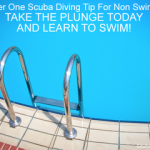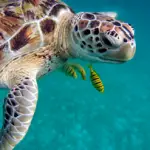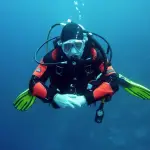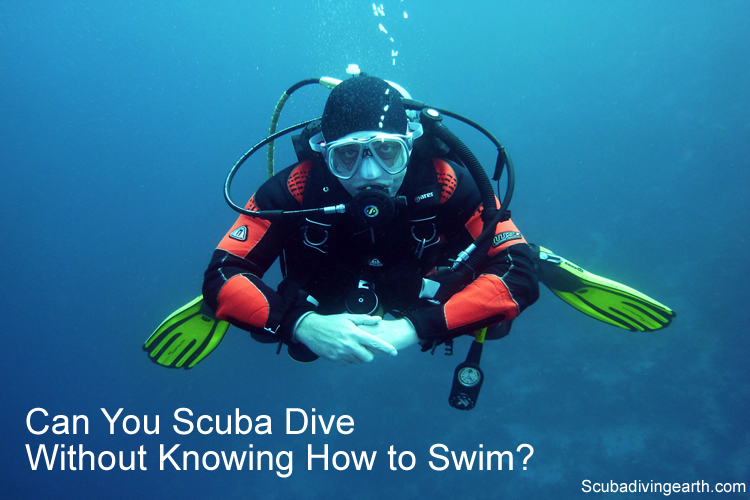
Can you scuba dive if you can’t swim?
When I first learnt to scuba dive it included a swimming test to make sure you were able to swim before the training started. It was a training course with BSAC (British Sub Aqua Club) and the training was rigorous, safe and thorough.
So can you scuba dive without knowing how to swim? Without knowing how to swim you cannot get your scuba certification. You need to be able to demonstrate basic water skills. Plus you must swim 200 metres (656 feet) in a swimming pool before you start your scuba training. Knowing how to swim is for your safety.
The best way to dive anywhere in the world is by a scuba diving liveaboard. You can check the latest and best deals on liveaboards using thew following window (opens in a new window):
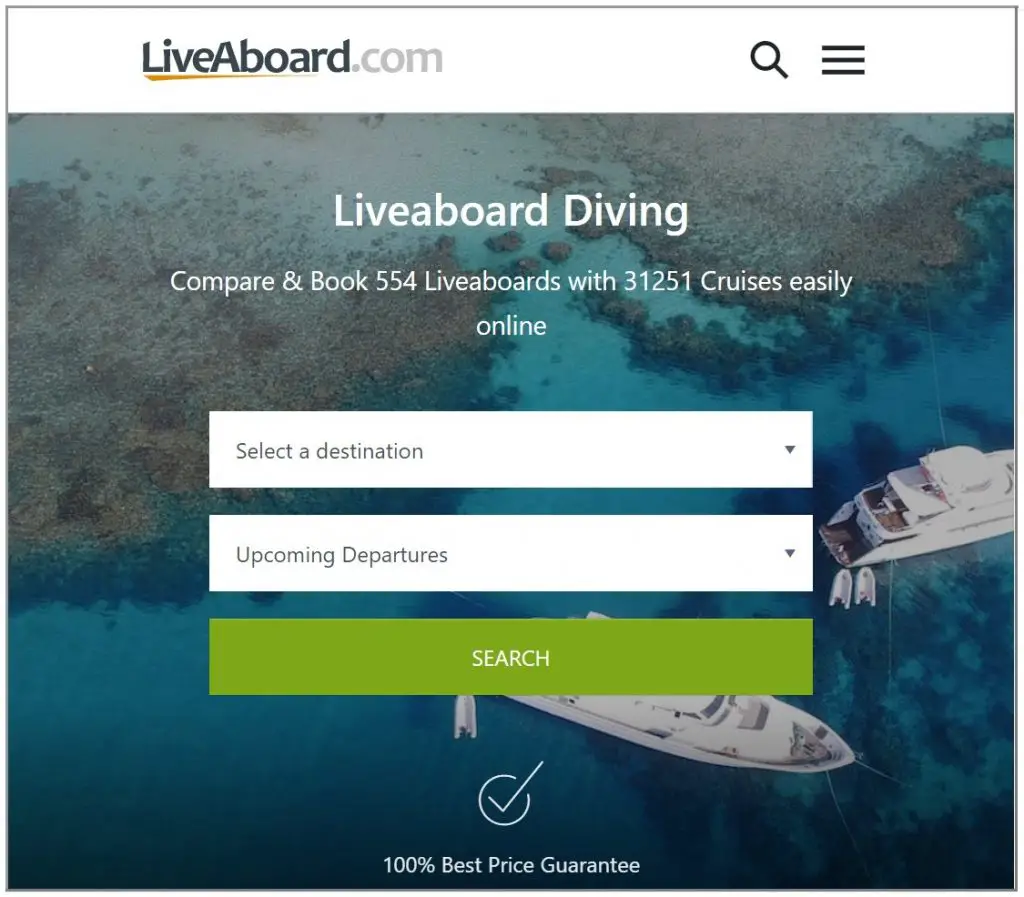
Or search our dive liveaboard pages here:
How far do I need to swim before I learn how to scuba dive?
Before you can learn to scuba dive you need to demonstrate basic water skills and to swim 200 metres (656 feet) in a swimming pool.
A part of that scuba diving training was not only about whether you could swim or not, but it was also about being able swim a few lengths of the swimming pool.
You also had to be able tread water with your hands above your head, for I think 10 minutes! It was a long time ago, so sorry I can’t remember exactly.
Before you begin your training with any reputable diving school, you will need to demonstrate your swimming skills.
Diver training is all about safety. The two top scuba diving schools that I’ve come into contact with are BSAC and PADI.
More Reading: PADI vs BSAC (Which diving qualification is better PADI or BSAC?)
Both these diving schools require you to be able to swim at least 200 metres (656 feet) in a swimming pool, before you can begin your training. Although PADI give you an option to swim for 300 metres (984 feet) in mask, fin and snorkel.
Regarding basic water skills, PADI have an additional requirement. Before you begin your Open Water Diving Course, you also need to demonstrate that you are able to float and tread water for 10 minutes. However, you can do this using any method you want.
As with learning any new skill, confidence plays a big part. This is no different with learning how to scuba dive.
So by having confidence in the water (i.e. knowing how to swim), this will help you to gain confidence when you progress through the scuba diving lessons.
Why is it important to know how to swim before I learn how to scuba dive?
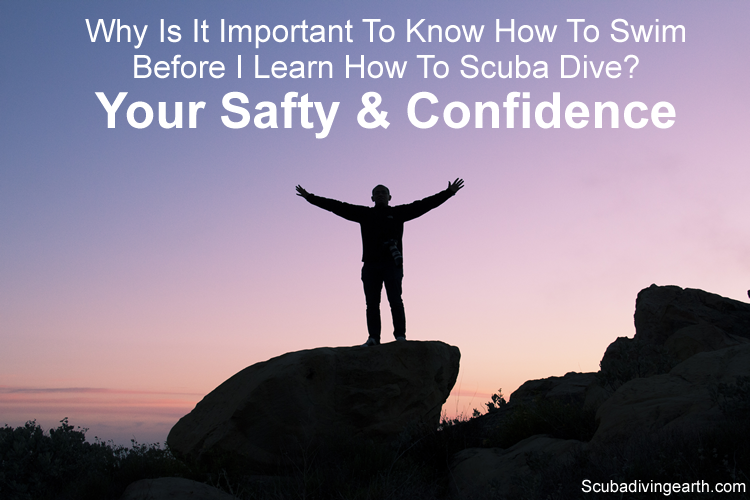
Whilst I want to keep this article on a level that doesn’t scare you away from wanting to learn how to scuba dive, I also want to help you understand why knowing how to swim is important. I want you to be safe and to enjoy diving as much as I love it!
If you start boat diving, which I hope you do as you get to see so much more, you’ll need to be able to swim away from and back to the boat. However, having said that, you will have fins on, which makes it so much easier to swim.
You need to know how to swim to scuba dive for safety reasons
Scuba diving is safe when you follow best practices and learn to dive with a reputable diver training school and with a good scuba diving instructor.
You want to be able to enjoy scuba diving, knowing that you will be safe. As with any sport, scuba diving comes with its own risks. In fact, scuba diving is regarded as a dangerous sport. But it’s only becomes dangerous if you don’t follow best practices.
You want to minimise the risk of injury or getting into trouble as far as you can. So having added confidence and being able to swim reduces this risk significantly.
But when you also follow best practices and dive safely, the risk associated with scuba diving is almost negligible.
As an aside; when you begin learning and then start to dive when you are on holiday, make sure you check your travel insurance cover. Some travel insurances don’t cover for scuba diving at all. Whereas the insurance companies that do, some may limit the type of diving you can do.
Most insurance companies simply restrict the depth to which you can dive (mostly around 30 metres (98 feet) max). The other diving that insurances companies shy away from is cave diving. So as long as you only intend to do ‘normal’ safe recreational diving, and nothing too extreme, your travel insurance policy will likely cover you for this, but please check before you go diving.
You need to know how to swim to scuba dive to give you confidence
As I’ve already mentioned, confidence is very important with any hobby or pastime. This is no different with scuba diving. When I taught scuba diving myself, I’d sometimes be teaching people who would get extremely nervous before a dive. The nervousness is about the unknown and it’s only natural.
It’s important to note that in the majority of cases, once the trainees got below the surface, and saw the fantastic things that are in our oceans, the fear and nervousness went away almost immediately.
There are always those that remain nervous some way into the dive too. But this is okay. Occasionally, some newbie scuba divers have their nervousness stay with them until they’ve done a few dives. But as they build up the number of dives they do, so does their confidence build too. And the nervousness goes away.
This is why all new divers are taken in with an instructor. The instructor is there to look after you and to help you to build your confidence.
This is why it’s so important to have confidence with water and to learn to swim first. So that you’re not adding yet further stress to yourself. Being able to swim is a big confidence step for anyone who is learning how to scuba dive.
Conserving air is the third factor
All scuba divers want to be able to stay under water for as long as possible. Depending on the depth of the dive, your fitness levels and how nervous you are in the water, these will all govern how long your air will last.
Women’s air tends to last longer underwater than it does for men. Which is probably due to the difference in our metabolic rates and the physical size difference between men and women.
Newbie scuba divers will usually guzzle their air more than confident veteran scuba divers. Also, women scuba divers air tends to last longer than it does for men scuba divers. I think this is down to the difference between the physical size of men vs women and the difference between our metabolic rates.
So whether you are a man or a women, and especially if you are a man, knowing how to swim and having a level of fitness, will help you to regulate and conserve your air much better. Which means you’ll spend more time under the water, your dives will be longer, and you will have more fun.
Which is what it’s all about!
What if I want to learn how to scuba dive but I can’t swim – What should I do?
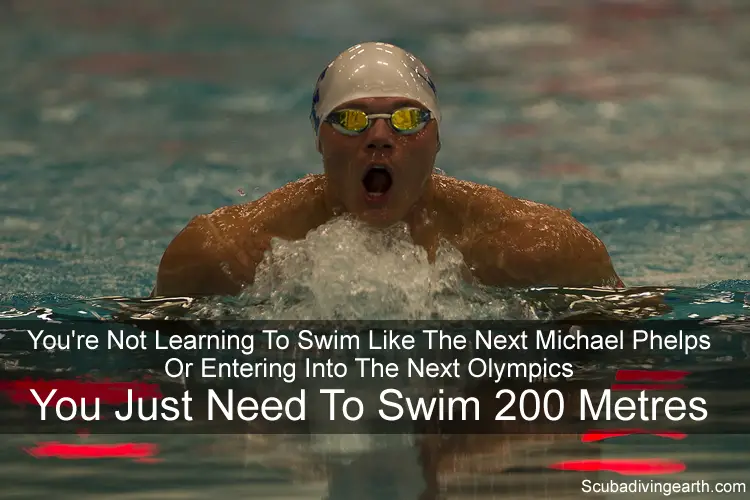
If you’ve always wanted to learn to scuba dive, but you are unable to swim, you will need to learn. Perhaps you are going on some exotic trip, where you’ll have the opportunity to scuba dive and you may wish to learn whilst you are there. Don’t leave it to the last minute, learn how to swim beforehand.
Learning to swim for scuba diving is about swimming just 200 metres (656 feet). You don’t have to become the next Michael Phelps.
Learning to swim is partly about confidence and partly about technique. If you are feeling a little under-confident, don’t worry you’re not alone in feeling this way.
As you learn to swim your confidence will build. And as you swim more your technique will improve.
You can easily join your local gym (where they have a swimming pool) or neighbourhood swimming pool and take up swimming lessons.
Swimming isn’t difficult and you’ll be with others similar to you who want to learn too. Keep your goal in mind when you book. When you arrive at the lesson, remember to always keep in mind your why you want to learn how to swim.
But most of all enjoy it. Swimming is fun and knowing how to swim opens up new opportunities. It really won’t take you that long to learn.
Also remember, you’re not learning to become the next Michael Phelps. You are not entering into the next Olympics. All you need to do is to learn how to swim 200 metres (656 feet). That’s it.
What type of swimming stroke do I need to learn to be able to scuba dive?
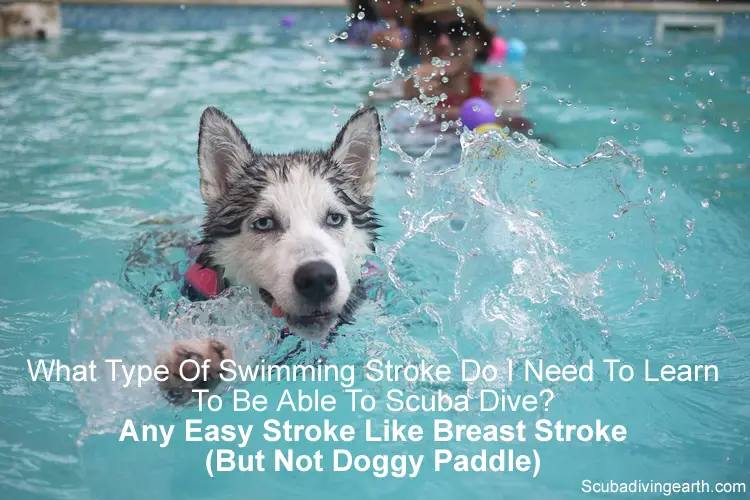
When you are learning to swim for the purpose of learning to scuba dive, the swimming stroke you use doesn’t really matter. You just need to be able to swim. I wouldn’t recommend doggy paddle though, but if that’s what you begin learning, then that’s okay.
Starting to learn is the key.
The swimming stroke you learn before you scuba dive is not important, but knowing how to swim is.
Choose a swimming stroke that’s easy. Don’t make things difficult for yourself.
I recommend using breast stroke, as this is the easiest to do and is less tiring when you swim. Speak with your instructor, and tell them why you want to learn to swim.
Explain to them you need to be able to swim 200 metres (656 feet) and to be able to float and tread water for 10 minutes (if you choose PADI).
Choose the easiest swimming stroke for you to learn in preparation for learning to scuba dive.
The floating and treading water will come naturally, as you learn to swim. So don’t worry about this exercise. Leave this towards the end of your swimming training. Trust me on this one, treading water will happen naturally, as you become more confident in the water.
You will probably find that your first lesson will be using a flotation device. To begin with, most swimming teachers will start by providing you with a float to hold in your hands. Then you’ll get comfortable swimming using only your legs.
However, don’t worry, they will start you off in the shallow end (where you’ll be able to touch the bottom). You will begin by learning to swim widths of the swimming pool at first.
You’ll be taught how to kick your legs, with your hands out in front of you holding the flotation device. Once you build your confidence with this stage of learning how to swim, the teacher will progress you to the next stage, and so on.
The next stage is learning how to use your arms, once you are confident with swimming using a float and kicking your legs.
All good swimming teacher will know that most people are nervous when they first start. They will take you through the learning stages slowly and at your pace.
How much does it cost to learn how to swim?
The cost associated with learning to swim will partly depend on whether you have private or group lessons.
Before you decide on how you want to be taught how to swim, you may consider whether you want to have private lessons or swimming lessons in a small group.
Private lessons will always be more expensive. However, the benefit of a private lesson is you will have the swimming teacher all to yourself. It will be much easier to go at your own pace and you won’t have any distractions from other learners.
However, although learning to swim in a group will not be private and you’ll not have the same level of individual attention, sometimes by learning in a group you get a sense of comradery. You will be able to encourage others and others will encourage you. You’ll see that you’re not alone in your quest to learn.
A bonus is you may even make new friends too.
So what does it cost to learn how to swim?
Depending on whether you choose to have private or group lessons the cost of learning how to swim ranges from $20-25 to be part of a group for a series of weekly training sessions. Whereas a private lesson may cost upwards of $10-15 for 20-30 minutes for one-to-one lessons.
You may be able to find someone who has their own private pool at their home, who provides private swimming lessons. Using someones private pool at their own home will be a much cheaper option than going to public swimming pool classes.
Try looking in your local newspaper ads or perhaps look on Gumtree for private adverts. Local supermarkets and convenience stores also display private adverts. Check these out too, if you’d prefer to have private lessons at someones home.
Be careful though to vet the person you are having the lessons with. Always be safe. Make sure you follow up testimonials from previous students who’ve been taught to swim by this person before you.
If you cannot find a private teacher at their own home, or if you prefer to use a public swimming baths instead, find details of your local swimming pool and ask them for the cost of their private and group training options.
Which way you choose how to learn to swim will be guided by what you are able to afford at the end of the day. How much time you have will play a role too.
You can even take swimming lesson holidays – here is one at Learn to Swim at Swim Inns, which costs from £399 ($535). This cost includes both the swimming lessons and the room in the hotel for the duration of the swimming course.
It’s cheaper if you share a room. So if you can find a friend or your partner will join you, the cost will be less per person. This is an expensive way of leaning how to swim, but if you have the money, it looks like a fab way to learn to me.
How much swimming will I do, once I’ve learnt how to dive?
Once you’ve learnt to scuba dive it won’t involve much swimming. With most of the swimming being done with fins on in any case.
Once you start scuba diving, the amount of actual swimming you do is very little. If you ignore the dive itself, which is mostly spent swimming with the aid of fins on your feet and at a very slowly pace, so that you conserve your air under water.
Normally, when you jump into the water, you have to swim to the marker buoy before you descend. Also, when you ascend and reach the surface, you will need to swim back to the boat.
All of this swimming is done with your fins on. So it’s actually very easy. You can do it at your own pace and the distance you have to swim is very short. The boat comes to you and you just swim the last small bit back to the boat.
Where the boat is tied to the marker buoy, all you’ll need to do is to swim to the front of the boat, meet your dive buddies and descend down the rope that leads to the bottom. This swimming distance will just be the length of the boat, which in most cases is very short. It will also be in your fins too.
What are the alternatives if I really don’t want to learn how to swim?
If you really don’t want to learn how to swim there are a few alternatives to learning to scuba diving.
The first of these is going in in a glass-bottomed boat. These are available in many parts of the Caribbean or in other tropical places around the world.
The glass bottom of the boat enables you to see below the surface. It’s not the same experience as scuba diving by any stretch of the imagination, but at least you’ll get to experience the colours of the reef and you’ll see the fish that live there too.
A better experience, which is closer to the scuba experience is to go down in a submarine. There’s one of these in Barbados, which I’ve not been in, but my mum has.
She said it was a great experience, and because she is disabled, it allowed her the opportunity to experience the undersea world that scuba divers get to experience.
Is fitness an important part in learning how to dive?
To scuba dive you don’t need to be extremely fit, but your level of fitness will affect how much you enjoy your diving.
Scuba diving does involve a certain amount of physical exertion. So if you are extremely unfit, this will impact your diving. I have known dive trip organisers and dive boat masters refuse someone based upon their level of fitness.
However, this was an extreme situation, whereby the person could hardly get on the boat at the dockside because of how unfit they were. Safety is a top priority for scuba diving, which is why they were refused.
This is because they’d find it almost impossible to get back on board the boat after a dive, and they could put the safety of the other divers at risk too.
Is learning to dive worth the effort of leaning to swim first?

I wanted to finish this article off with a bit of inspiration. I really want you to take that next step. Learn how to swim and learn how to scuba dive too.
Diving allows you to enter a whole new underwater world of beautiful and wonderful sea creatures. You also get to see some amazing underwater scenes, shipwrecks and other wonderful artifacts.
Diving is so much fun. It’s a very social sport and you get to meet some wonderful people too. These wonderful people include the people you dive with and the diving instructors and boat skippers alike.
I have made some good friends through diving. Most recently on some dives I did in Barbados, I met some friends who my wife and I keep in contact with when we returned home to the UK.
When you dive, you get to see some wonderful things. You enter a whole new underwater world and see some beautiful and amazing creatures. From the small little critters that hide and scurry around on the sea bed and in between the corals, through to some very large sea dwelling animals like seals, dolphins, sea turtles and my favourite…sharks.
More Reading: Recovery of the Junkers Jumo 211 (recovery of underwater artifacts)
I hope you enjoyed this article about can you scuba dive without knowing how to swim
I’d love to hear from you and your adventures of diving in the comments below. Please also share your photos from your underwater cameras or video from your waterproof go-pro’s!
If this article hasn’t answered all of your questions about can you scuba dive without knowing how to swim and why it’s important to learn how to swim beforehand, please comment below with your questions. There will also be many more articles about scuba diving for you to read and learn about this fabulous sport.
Have fun and be safe!

